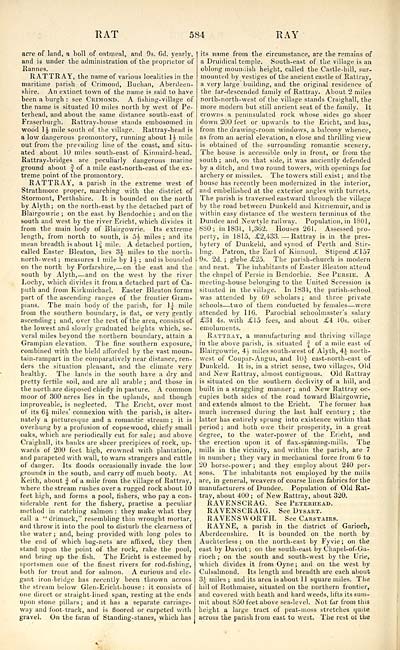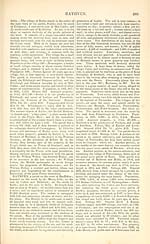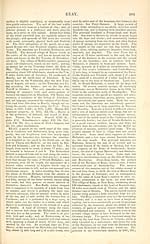Topographical, statistical, and historical gazetteer of Scotland > Volume 2
(600) Page 584
Download files
Complete book:
Individual page:
Thumbnail gallery: Grid view | List view

RAT
584
RAY
acre of land, a boll of oatmeal, and 9s. Gd. yearly,
and is under the administration of the proprietor of
Rannes.
RATTRAY, the name of various localities in the
maritime parish of Crimond, Buchan, Aberdeen-
shire. An extinct town of the name is said to have
been a burgh : see Crimond. A fishing-village of
the name is situated 10 miles north by west of Pe-
terhead, and about the same distance south-east, of
Fraserburgh. Rattray-house stands embosomed in
wood 1J mile south of the village. Rattray-head is
a low dangerous promontory, running about li mile
out from the prevailing line of the coast, and situ-
ated about 10 miles south-east of Kinnaird-head.
Rattray-bridges are peculiarly dangerous marine
ground about J of a mile east-north-east of the ex-
treme point of the promontory.
RATTRAY, a parish in the extreme west of
Strathmore proper, marching with the district of
Stormont, Perthshire. It is bounded on the north
by Alyth; on the north-east by the detached part of
Blairgowrie ; on the east by Bendochie ; and on the
south and west by the river Ericht, which divides it
from the main body of Blairgowrie. Its extreme
length, from north to south, is 5^ miles ; and its
mean breadth is about lj mile. A detached portion,
called Easter Bleaton, lies 3| miles to the north-
north-west; measures I mile by H ; and is bounded
on the north by Forfarshire, — on the east and the
south by Alyth, — and on the west by the river
Lochy, which divides it from a detached part of Ca-
puth and from Kirkmichael. Easter Bleaton forms
part of the ascending ranges of the frontier Gram-
pians. The main body of the parish, for ]A mile
from the southern boundary, is flat, or very gently
ascending; and, over the rest of the area, consists of
the lowest and slowly graduated heights which, se-
veral miles beyond the northern boundary, attain a
Grampian elevation. The fine southern exposure,
combined with the bield afforded by the vast moun-
tain-rampart in the comparatively near distance, ren-
ders the situation pleasant, and the climate very
healthy. The lands in the south have a dry and
pretty fertile soil, and are all arable ; and those in
the north are disposed chiefly in pasture. A common
moor of 300 acres lies in the uplands, and though
improveable, is neglected. The Ericht, over most
of its 6£ miles' connexion with the parish, is alter-
nately a picturesque and a romantic stream ; it is
overhung by a profusion of copsewood, chiefly small
oaks, which are periodically cut for sale; and above
Craigball, its banks are sheer precipices of rock, up-
wards of 200 feet high, crowned with plantation,
and parapeted with wall, to warn strangers and cattle
of danger. Its floods occasionally invade the low
grounds in the south, and carry off much booty. At
Keith, about J of a mile from the village of Rattray,
where the stream rushes over a rugged rock about 10
feet high, and forms a pool, fishers, who pay a con-
siderable rent for the fishery, practise a peculiar
method in catching salmon : they make what they
call a " drimuck," resembling thin wrought mortar,
and throw it into the pool to disturb the clearness of
the water ; and, being provided with long poles to
the end of which bag-nets are affixed, they then
stand upon the point of the rock, rake the pool,
and bring up the fish. The Ericht is esteemed by
sportsmen one of the finest rivers for rod-fishing,
both for trout and for salmon. A curious and ele-
gant iron-bridge has recently been thrown across
the stream below Glen-Ericht-house : it consists of
one direct or straight-lined span, resting at the ends
upon stone pillars ; and it has a separate carriage-
way and foot- track, and is floored or carpeted with
gravel. On the farm of Standing-stanes, which has
its name from the circumstance, are the remains of
a Druidical temple. South-east of the village is an
oblong moundish height, called the Castle-hill, sur-
mounted by vestiges of the ancient castle of Rattray,
a very large building, and the original residence of
the far-descended family of Rattray. About 2 miles
north-north-west of the village stands Craighall, the
more modern but still ancient seat of the family. It
crowns a peninsulated rock whose sides go sheer
down 200 feet or upwards to the Ericht, and has,
from the drawing-room windows, a balcony whence,
as from an aerial elevation, a close and thrilling view
is obtained of the surrounding romantic scenery.
The house is accessible only in front, or from the
south ; and, on that side, it was anciently defended
by a ditch, and two round towers, with openings for
archery or missiles. The towers still exist ; and the
house has recently been modernized in the interior,
and embellished at the exterior angles with turrets.
The parish is traversed eastward through the village
by the road between Dunkeld and Kirriemuir, and is
within easy distance of the western terminus of the
Dundee and Newtvle railway. Population, in 1801,
8S0; in 1831, 1,362. Houses 261. Assessed pro-
perty, in 1815, £2,433. — Rattray is in the pres-
bytery of Dunkeld, and synod of Perth and Stir-
ling. Patron, the Earl of Kinnoul. Stipend £157
9s. 2d. ; glebe £25. The parish-church is modern
and neat. The inhabitants of Easter Bleaton attend
the chapel of Persie in Bendochie. See Persie. A
meeting-house belonging to the United Secession is
situated in the village. In 1831, the parish-school
was attended by 69 scholars; and three private
schools — two of them conducted by females — were
attended by 116. Parochial schoolmaster's salary
£3-1 4s. with £15 fees, and about £4 10s. other
emoluments.
Rattray, a manufacturing and thriving village
in the above parish, is situated '^ of a mile east of
Blairgowrie, 4^ miles south-west of Alyth, 4i north-
west of Coupar- Angus, and 1U;} east-north-east of
Dunkeld. It is, in a strict sense, two villages, Old
and New Rattray, almost contiguous. Old Rattray
is situated on the southern declivity of a hill, and
built in a straggling manner; and New Rattray oc-
cupies both sides of the road toward Blairgowrie,
and extends almost to the Ericht. The former has
much increased during the last half century ; the
latter has entirely sprung into existence within that
period ; and both owe their prosperity, in a great
degree, to the water-power of the Ericht, and
the erection upon it of flax-spinning-mills. The
mills in the vicinity, and within the parish, are 7
in number; they vary in mechanical force from 6 to
20 horse-power ; and they employ about 240 per-
sons. The inhabitants not employed by the mills
are, in general, weavers of coarse linen fabrics for the
manufacturers of Dundee. Population of Old Rat-
tray, about 400 ; of New Rattray, about 320.
RAVENSCRAG. See Peterhead.
RAVENSCRAIG. See Dysart.
RAVENSWORTH. See Carstairs.
RAYNE, a parish in the district of Garioch,
Aberdeenshire. It is bounded on the north by
Auchterless ; on the north-east by Fyvie; on the
east by Daviot ; on the south-east hy Chapel-of-Ga-
rioch ; on the south and south-west by the Urie,
which divides it from Oyne; and on the west by
Culsalmond. Its length and breadth are each about
3J- miles ; and its area is about 1 1 square miles. The
hill of Rothmaise, situated on the northern frontier,
and covered with heath and hard weeds, lifts its sum-
mit about 850 feet above sea-level. Not far from tins
height a large tract of peat-moss stretches quite
across the parish from east to west. The rest of the
584
RAY
acre of land, a boll of oatmeal, and 9s. Gd. yearly,
and is under the administration of the proprietor of
Rannes.
RATTRAY, the name of various localities in the
maritime parish of Crimond, Buchan, Aberdeen-
shire. An extinct town of the name is said to have
been a burgh : see Crimond. A fishing-village of
the name is situated 10 miles north by west of Pe-
terhead, and about the same distance south-east, of
Fraserburgh. Rattray-house stands embosomed in
wood 1J mile south of the village. Rattray-head is
a low dangerous promontory, running about li mile
out from the prevailing line of the coast, and situ-
ated about 10 miles south-east of Kinnaird-head.
Rattray-bridges are peculiarly dangerous marine
ground about J of a mile east-north-east of the ex-
treme point of the promontory.
RATTRAY, a parish in the extreme west of
Strathmore proper, marching with the district of
Stormont, Perthshire. It is bounded on the north
by Alyth; on the north-east by the detached part of
Blairgowrie ; on the east by Bendochie ; and on the
south and west by the river Ericht, which divides it
from the main body of Blairgowrie. Its extreme
length, from north to south, is 5^ miles ; and its
mean breadth is about lj mile. A detached portion,
called Easter Bleaton, lies 3| miles to the north-
north-west; measures I mile by H ; and is bounded
on the north by Forfarshire, — on the east and the
south by Alyth, — and on the west by the river
Lochy, which divides it from a detached part of Ca-
puth and from Kirkmichael. Easter Bleaton forms
part of the ascending ranges of the frontier Gram-
pians. The main body of the parish, for ]A mile
from the southern boundary, is flat, or very gently
ascending; and, over the rest of the area, consists of
the lowest and slowly graduated heights which, se-
veral miles beyond the northern boundary, attain a
Grampian elevation. The fine southern exposure,
combined with the bield afforded by the vast moun-
tain-rampart in the comparatively near distance, ren-
ders the situation pleasant, and the climate very
healthy. The lands in the south have a dry and
pretty fertile soil, and are all arable ; and those in
the north are disposed chiefly in pasture. A common
moor of 300 acres lies in the uplands, and though
improveable, is neglected. The Ericht, over most
of its 6£ miles' connexion with the parish, is alter-
nately a picturesque and a romantic stream ; it is
overhung by a profusion of copsewood, chiefly small
oaks, which are periodically cut for sale; and above
Craigball, its banks are sheer precipices of rock, up-
wards of 200 feet high, crowned with plantation,
and parapeted with wall, to warn strangers and cattle
of danger. Its floods occasionally invade the low
grounds in the south, and carry off much booty. At
Keith, about J of a mile from the village of Rattray,
where the stream rushes over a rugged rock about 10
feet high, and forms a pool, fishers, who pay a con-
siderable rent for the fishery, practise a peculiar
method in catching salmon : they make what they
call a " drimuck," resembling thin wrought mortar,
and throw it into the pool to disturb the clearness of
the water ; and, being provided with long poles to
the end of which bag-nets are affixed, they then
stand upon the point of the rock, rake the pool,
and bring up the fish. The Ericht is esteemed by
sportsmen one of the finest rivers for rod-fishing,
both for trout and for salmon. A curious and ele-
gant iron-bridge has recently been thrown across
the stream below Glen-Ericht-house : it consists of
one direct or straight-lined span, resting at the ends
upon stone pillars ; and it has a separate carriage-
way and foot- track, and is floored or carpeted with
gravel. On the farm of Standing-stanes, which has
its name from the circumstance, are the remains of
a Druidical temple. South-east of the village is an
oblong moundish height, called the Castle-hill, sur-
mounted by vestiges of the ancient castle of Rattray,
a very large building, and the original residence of
the far-descended family of Rattray. About 2 miles
north-north-west of the village stands Craighall, the
more modern but still ancient seat of the family. It
crowns a peninsulated rock whose sides go sheer
down 200 feet or upwards to the Ericht, and has,
from the drawing-room windows, a balcony whence,
as from an aerial elevation, a close and thrilling view
is obtained of the surrounding romantic scenery.
The house is accessible only in front, or from the
south ; and, on that side, it was anciently defended
by a ditch, and two round towers, with openings for
archery or missiles. The towers still exist ; and the
house has recently been modernized in the interior,
and embellished at the exterior angles with turrets.
The parish is traversed eastward through the village
by the road between Dunkeld and Kirriemuir, and is
within easy distance of the western terminus of the
Dundee and Newtvle railway. Population, in 1801,
8S0; in 1831, 1,362. Houses 261. Assessed pro-
perty, in 1815, £2,433. — Rattray is in the pres-
bytery of Dunkeld, and synod of Perth and Stir-
ling. Patron, the Earl of Kinnoul. Stipend £157
9s. 2d. ; glebe £25. The parish-church is modern
and neat. The inhabitants of Easter Bleaton attend
the chapel of Persie in Bendochie. See Persie. A
meeting-house belonging to the United Secession is
situated in the village. In 1831, the parish-school
was attended by 69 scholars; and three private
schools — two of them conducted by females — were
attended by 116. Parochial schoolmaster's salary
£3-1 4s. with £15 fees, and about £4 10s. other
emoluments.
Rattray, a manufacturing and thriving village
in the above parish, is situated '^ of a mile east of
Blairgowrie, 4^ miles south-west of Alyth, 4i north-
west of Coupar- Angus, and 1U;} east-north-east of
Dunkeld. It is, in a strict sense, two villages, Old
and New Rattray, almost contiguous. Old Rattray
is situated on the southern declivity of a hill, and
built in a straggling manner; and New Rattray oc-
cupies both sides of the road toward Blairgowrie,
and extends almost to the Ericht. The former has
much increased during the last half century ; the
latter has entirely sprung into existence within that
period ; and both owe their prosperity, in a great
degree, to the water-power of the Ericht, and
the erection upon it of flax-spinning-mills. The
mills in the vicinity, and within the parish, are 7
in number; they vary in mechanical force from 6 to
20 horse-power ; and they employ about 240 per-
sons. The inhabitants not employed by the mills
are, in general, weavers of coarse linen fabrics for the
manufacturers of Dundee. Population of Old Rat-
tray, about 400 ; of New Rattray, about 320.
RAVENSCRAG. See Peterhead.
RAVENSCRAIG. See Dysart.
RAVENSWORTH. See Carstairs.
RAYNE, a parish in the district of Garioch,
Aberdeenshire. It is bounded on the north by
Auchterless ; on the north-east by Fyvie; on the
east by Daviot ; on the south-east hy Chapel-of-Ga-
rioch ; on the south and south-west by the Urie,
which divides it from Oyne; and on the west by
Culsalmond. Its length and breadth are each about
3J- miles ; and its area is about 1 1 square miles. The
hill of Rothmaise, situated on the northern frontier,
and covered with heath and hard weeds, lifts its sum-
mit about 850 feet above sea-level. Not far from tins
height a large tract of peat-moss stretches quite
across the parish from east to west. The rest of the
Set display mode to: Large image | Transcription
Images and transcriptions on this page, including medium image downloads, may be used under the Creative Commons Attribution 4.0 International Licence unless otherwise stated. ![]()
| Gazetteers of Scotland, 1803-1901 > Topographical, statistical, and historical gazetteer of Scotland > Volume 2 > (600) Page 584 |
|---|
| Permanent URL | https://digital.nls.uk/97455790 |
|---|
| Description | Volume second: I-Z. |
|---|---|
| Shelfmark | Map Room Ref.2 |
| Attribution and copyright: |
|

